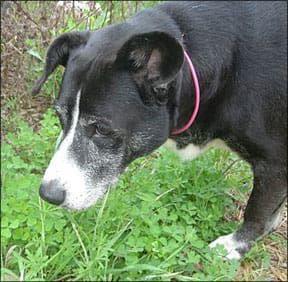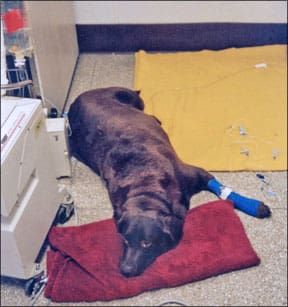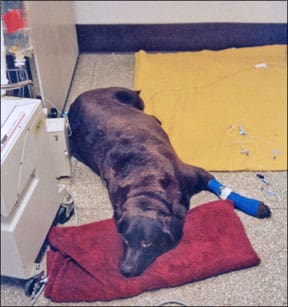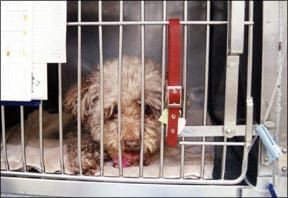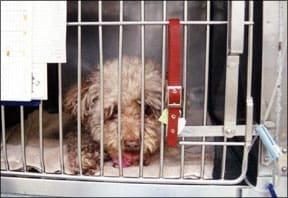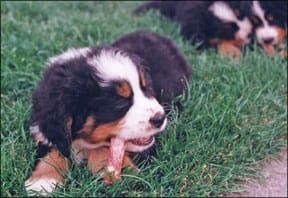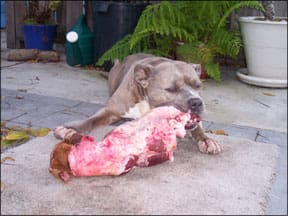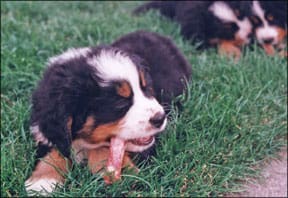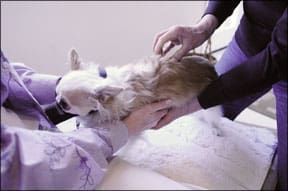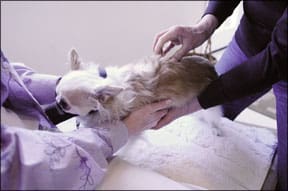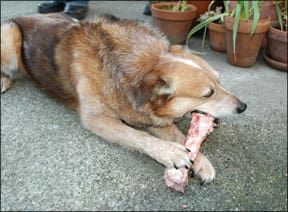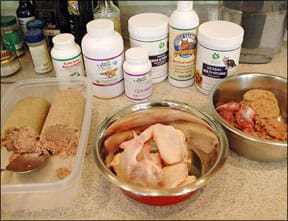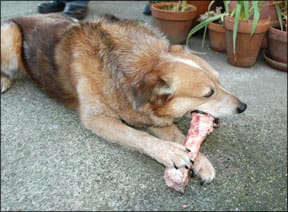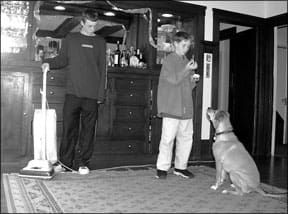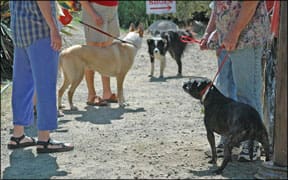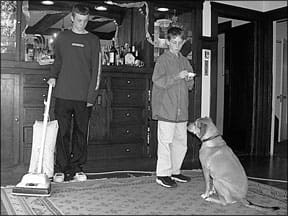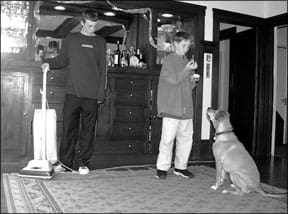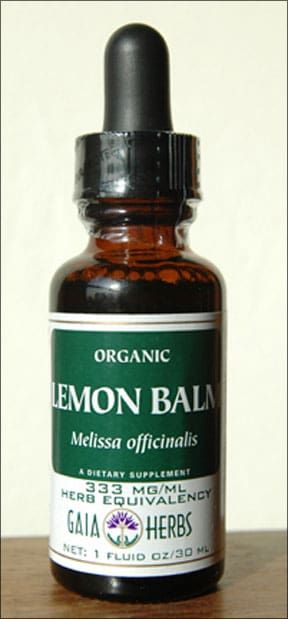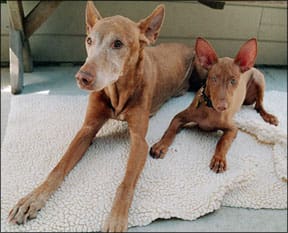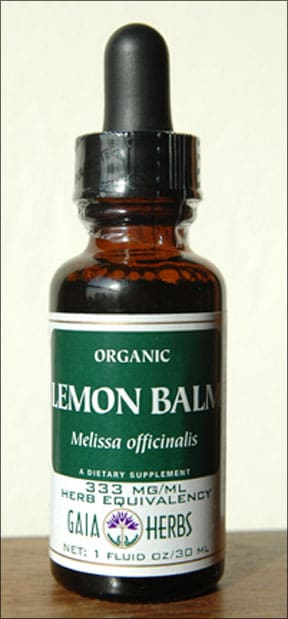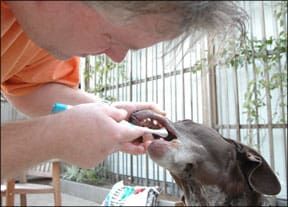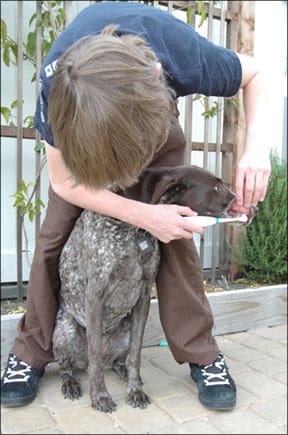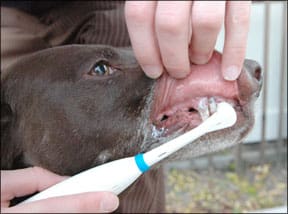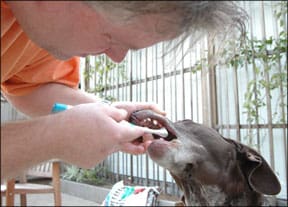Ask a dozen health experts about allergies and you’ll get at least that many theories about what they are, why they happen, and how to fix them.
What’s interesting is that even when they disagree, most allergy theories point to the same underlying causes. This is because allergic reactions are symptoms of a deeper imbalance. Dogs don’t develop allergies because they are exposed to allergens. Dogs are exposed to allergens all the time, usually with no reaction. Dogs develop allergies with implications of skin problems because something has made them vulnerable, and the culprit is often a combination of diet, stress, conventional medical treatments, heredity, and environmental factors.
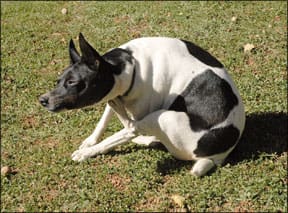
Four months ago we explored Candida albicans (“Canine Candida,” February 2007), considered by some to be a major factor in canine allergies. This article explores the links between canine allergies and leaky gut syndrome, a different species of yeast called Malassezia pachydermatis, and detoxification support.
Leaky Gut Syndrome in Dogs
Also known as intestinal permeability, leaky gut syndrome is exactly what it sounds like, a condition in which damage to the small intestine creates spaces between cells in the intestinal lining, spaces that are large enough to allow fragments of partially digested food, toxins, and bacteria to migrate from the intestinal tract into the bloodstream. The results include impaired digestion, incomplete absorption of nutrients, and the presence of what the immune system identifies as foreign invaders throughout the body. The immune system responds with its usual weapons, which produce inflammation and allergic reactions.
Soon the liver and kidneys, the body’s main filters, become overwhelmed, and toxins spill over into the bloodstream, which carries bacteria, toxins, and partially digested food particles to muscles and connective tissue throughout the body. Leaky gut syndrome is blamed for respiratory and skin allergies, arthritis, irritable bowel disease, autoimmune disorders, diabetes, and a host of other problems.
Leaky gut syndrome is a vicious cycle. Something (usually diet-related) causes injury to the small intestine, resulting in impaired digestion, which leads to bacterial overgrowth and other problems, resulting in further damage, and the cycle continues. Some of the conditions blamed for leaky gut syndrome include high-carbohydrate diets, antibiotics, parasites, yeast or fungal infections, nonsteroidal anti-inflammatory drugs, and mineral deficiencies. Some of these, such as parasite infestations, yeast or fungal infections, and mineral deficiencies, can result from the syndrome as well as help cause it.
At Reinhardt Ranch Holistic Nutrition Center for Pets in Elk Grove, California, nutritional consultant Elaine Reinhardt hears every day from people whose dogs have chronic allergies. “Leaky gut syndrome is at the root of many illnesses,” she says, “including autoimmune diseases, joint diseases, and allergic reactions. Since much of your immune function is in your gut, it makes sense to look there first. Certainly this is true when it comes to allergies.”
A large number of the dogs she works with were adopted from shelters or rescue groups. Most, she says, are underweight. Even in their new homes and on an improved diet, they can’t gain an ounce. Reinhardt suspects that conditions that interfere with their gaining weight, such as leaky gut syndrome and malabsorption, contribute to behavioral problems, hyperactivity, and other factors that prompted their previous owners to give them up. “Add all the health problems that come with leaky gut syndrome and an inflamed intestinal tract,” she says, “and the expense of conventional medical treatment, and I suspect that many of these dogs were given up because their owners couldn’t afford the time and expense their treatment required.”
Symptoms as varied as ear infections; seasonal or respiratory allergies; itchy skin; hair and coat problems; diarrhea; and an inability to gain weight can all stem from digestive problems, she says.
To heal the digestive tract, Reinhardt recommends an improved diet with higher-quality protein and the elimination of soy, corn, wheat, and chicken fat. “Soy, corn, and wheat are at the top of the list of foods that irritate canine digestion,” she says, “and I like to stay away from chicken fat because it contains residues of whatever the chicken was exposed to in the way of drugs and toxins. Fat from organically raised, pastured chickens is fine, but that’s not what you’ll find in commercial dog food.”
Reinhardt then recommends three supplements that she considers crucial for rapid healing and recovery: Seacure, probiotics, and digestive enzymes.
Seacure, described in “Securing Seacure” (April 2003) and “Accelerated Wound Healing” (August 2006), is a very fishy smelling powder made from fermented deep sea white fish. Because the fermentation process predigests the fish and breaks it into amino acids and peptides, which the body uses as building blocks to repair damaged tissue and speed healing, it requires no digestive effort and is assimilated on contact.
“I started taking Seacure seriously,” says Reinhardt, “when I gave it to some cats who were dying. They literally responded within 15 minutes. Their eyes went from dull to sparkling in that short a time. Since then, I’ve seen the same response again and again, including seriously ill and unresponsive dogs who sat up, began grooming themselves, wagged their tails, interacted with their owners, and took an interest in their surroundings, all within 15 minutes. I’m not saying that they all get well, but when any pet in dire straits responds dramatically, it’s wonderful.”
In most cases, she says, underweight dogs and dogs with allergy symptoms begin to improve within a few days, and within a month or two, they have gained weight, their coats have improved, bald spots have disappeared, and they no longer chew on their paws. “The food that goes in stays in,” she says. “It doesn’t come shooting out the other end as bright yellow diarrhea. Seacure provides the deep nourishment that helps with conditions across the board.”
Reinhardt usually starts with the label-recommended dose of ¼ teaspoon per 10 pounds of body weight per day, but for dogs weighing over 100 pounds, she finds that 2½ teaspoons works well. “Larger animals don’t necessarily need a greater dose,” she says, “and dogs who don’t need a lot of digestive support do well on half the recommended dose.”
Reinhardt says that when she adds probiotics (beneficial bacterial) and digestive enzymes, the dogs’ health improves even faster.
Some probiotics (see “Probiotics Boost Canine Overall Health,” August 2006) are labeled for pet or veterinary use. Among the many strains of probiotics for which canine health claims are made, one of the most interesting is Lactobacillus sporogenes. Unlike L. acidophilus and similar strains, L. sporogenes reproduces rapidly, so it acts faster in keeping yeasts and fungi in check. Some human product lines, such as Thorne Research, carry L. sporogenes supplements, which can be safely given to dogs.
Several canine probiotic supplements, such as Jarrow Formula’s Pet Dophilus Powder, contain Enterococcus faecium, a strain that is native to dogs and which some nutrition experts consider essential to canine health.
Enzyme products that have helped dogs with allergies include digestive enzymes that are added to food, such as Prozyme and NZymes, and systemic oral enzymes, such as Wobenzym and FlavenZym, which are given between meals on an empty stomach (see “Enzyme Therapy for Quicker Canine Injury Recovery,” January 2001, and “Digest These Benefits,” October 2005).
Reinhardt prefers PetLabs360 DigestAbles tablets. “They’re chewable,” she says, “so they can be fed directly to dogs or put in their food. They’re beef and cheese flavored, so even finicky dogs like them, and the results are excellent.”
Her favorite product for dogs suffering from airborne allergens is SeaVive, a companion product to Seacure. SeaVive contains Seacure, colostrum, Beta-1,3-D glucan, and vitamin C.
Another supplement that has helped dogs with all types of allergies is Willard Water (see “Willard Water,” June 2006), which can be added to drinking water or herbal tea and diluted and added to food to improve digestion and increase the assimilation of nutrients.
Malassezia
Malassezia pachydermatis is a yeast commonly found in the ears and on the skin of dogs. Held in check by the immune systems of healthy dogs, it can multiply until it becomes pathogenic in susceptible dogs, resulting in itchy, oily, or scaly skin, hair loss, redness or blackening of the skin, thickening of the skin, and an offensive greasy odor.
Affected areas tend to be the ears and skin folds on or around the face, elbow, underarm, and tail. Dogs with an overgrowth of Malassezia may lick their feet incessantly because of atopic or environmental allergies that accompany the yeast overgrowth. Cocker Spaniels, Basset Hounds, and West Highland White Terriers are said to be especially susceptible, but any dog can experience a Malassezia overgrowth.
Malassezia yeast cells can be identified under a microscope. A skin lesion can be scraped or swabbed, or a sample can be collected on scotch tape. Conventional veterinary treatment of Malassezia usually involves a shampoo containing one or more topical antifungal medications, such as miconazole, clortrimazole, or ketocanazole. Oral anti-fungal drugs are prescribed in cases that don’t respond to topical treatment.
Holistic veterinarian Susan Wynn, DVM, thinks that Melassezia, not Candida, is implicated in many itchy dogs’ uncomfortable plight. “Malassezia is a yeast species that can cause thickened, hyperpigmented skin, bad ears, fatigue, and lethargy,” she says. “Of course, Malassezia is also a secondary problem to whatever is going on with the dog. Malassezia is the primary yeast that causes opportunistic (secondary) infections in dogs and is diagnosed regularly on the skin or in the ears. Secondary infections by Candida albicans are possible but much more rare, and most of the holistic veterinarians I know treat leaky gut syndrome instead of candidiasis.”
Dr. Wynn does not believe treatment with anti-fungal medications or herbs is always necessary before giving an affected dog probiotics and changing the dog’s diet, and she emphasizes that leaky gut syndrome can occur independently of candida overgrowth.
For Malassezia-infected ears, Dr. Wynn recommends daily cleaning with vinegar diluted with an equal amount of water, which is a gentle way to lower the pH in the ear, making it less hospitable to yeasts and fungi. A pinch of boric acid has a similar effect (as described in “A New Old Ear Treatment,” June 2004). For topical treatment of the skin, Dr. Wynn recommends Selsun Blue shampoo or the application of a 10-percent tea tree oil spray, which has proven antifungal properties.
Our literature search of holistic treatments for Malassezia produced recommendations identical to holistic treatments for candidiasis. “You’ve discovered exactly the point,” says Dr. Wynn. “And if you look further, you will discover that the treatment is very much like what we recommend for any chronic allergic or immune-mediated disease, many of them centering on abnormal gut permeability.
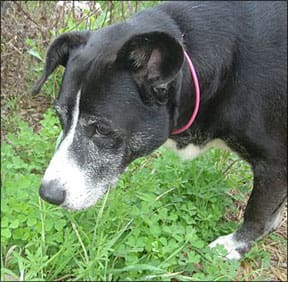
“To wit, we have diseases that respond to diet changes, probiotics, and various herbal tonics or specifics, and we can only document the presence of fungi in some cases, so we look for a different cause. This is why so many veterinary practitioners look at chronic yeast infections as a problem that pops up in immunocompromised animals and not as the primary disease. Holistic treatments like improved diet and probiotics work, but they work directly on the immune system, strengthening the body so that it resists yeast, rather than by killing the yeast directly.”
Dr. Wynn almost never recommends conventional antifungals like Nystatin for Malassezia, finding that Selsun Blue shampoos works well for all but the most serious cases in combination with holistic treatment for leaky gut syndrome.
Detoxification Support
Most of us think of detoxification as something that happens when we go on a “detox” program of fasting, herbs, juices, or supplements that speed the body’s release of impurities. In fact, detoxification goes on constantly as the body breaks down and removes waste products.
If the liver receives the nutrients it needs to perform this function well, it maintains itself in a state of health. If the process is impaired, health suffers. Unfortunately, dogs are often overwhelmed with the burden of detoxification – and undernourished by low-quality commercial diets. This combination can contribute to leaky gut syndrome, yeast overgrowth, and a variety of allergy symptoms.
During the first stage of the detoxification process (Phase I), the body’s filters identify and separate waste products and toxins from the blood and lymph. Water-soluble material gets sent to the kidneys for excretion. Dehydration complicates this process, which is why consuming clean drinking water is so important. Additional nutrients are required by the liver to perform Phase II functions, the elimination of materials that couldn’t be made water-soluble in Phase I.
When a dog is deficient in key nutrients, backups and spillovers of waste products can occur. Partially processed toxins traveling through the bloodstream may find a home in fatty tissue, or they may stay in the blood, infect healthy tissue, and cause new illnesses. Incomplete detoxification and leaky gut syndrome (and the allergy symptoms they aggravate) can be corrected with an improved diet and supplements that support the digestive tract.
Seacure, described above, is an important whole-food source of amino acids and an aid to Phase II detoxification. Digestive enzymes taken between meals help support the process. So do whole-food nutritional supplements, such as Standard Process Canine Dermal Support, which targets skin conditions, or Canine Hepatic Support, which improves liver function.
Dogs are well known for finding their own treatments when given the opportunity. Renee Votta, an herbalist in New Braunfels, Texas, adopted a mixed-breed dog she found. “We had just had a huge flood, and many animals were homeless due to houses being destroyed and animals being caught in the river. I looked for her owners but no one claimed her.”
Votta named the dog Bonnie and took her to a veterinary clinic for spaying and to have the open sores on her legs treated. “She licked at them all the time,” says Votta. “Most were an inch wide and an inch long, some smaller and a few larger. The vet said they were caused by contact dermatitis having something to do with the grass, weeds, and green things that grow here all year. The vet said we would have to live with them because it’s the kind of problem that keeps coming back.”
That winter, Votta experimented with topical treatments. A mix of aloe vera, vitamin E, and olive oil worked best, but even though the sores got smaller, they never went away and new sores often developed.
One day, Votta realized that Bonnie, standing in a weed patch, was carefully harvesting cleavers (Galium aparine). “I couldn’t get over it,” she says. “Bonnie was ignoring all the other weeds. At that moment I realized that her condition had nothing to do with external factors. Her problems were inside her.”
Votta encouraged Bonnie to eat all the cleavers she wanted from the yard, plus she made cleavers tea to add to the dog’s water. She also added minced cleavers and raw garlic to Bonnie’s dry food.
Within a month, all of the sores on Bonnie’s legs cleared up and in the eight years since, she has never had another open sore. She continues to graze on cleavers, especially when the plants first emerge in the spring. “Eating a few strands of them every so often is enough to keep her healthy and her blood clean,” says Votta.
In her book Veterinary Herbal Medicine, Dr. Wynn describes cleavers as a mildly astringent and mildly diuretic herb that is a tonic for the lymph system. It has been used for dry skin eruptions, as a remedy for ulcers and tumors, and for the treatment of psoriasis. In All You Ever Wanted to Know about Herbs for Pets, Mary Wulff-Tilford and Gregory Tilford describe cleavers as an herb that enhances the body’s waste management by improving lymphatic circulation, thus “washing” body tissues.
Because cleavers is an invasive weed with a wide range, it’s probably growing in your neighborhood. Consult a plant identification guide or search for cleavers online; several herbal websites offer descriptions and photos. In addition to having a distinctive appearance, cleavers feels sticky to the touch and clings to whatever it contacts. Avoid herbs that grow near highways, busy parking lots, or fields treated with pesticides or agricultural chemicals.
To try Bonnie’s remedy, finely chop or mince fresh cleavers and add it to your dog’s food, starting with small amounts and increasing to about 1 tablespoon minced herb per 25 to 30 pounds of body weight per day in divided doses. For convenience, store fresh cleavers in the freezer by pureeing the herb in a small amount of water, placing it in ice cube trays, and as soon as it’s frozen, transfer to a tightly sealed plastic bag. Remove a cube at a time as needed.
Dried wildcrafted cleavers can be ordered from Jean’s Greens and other herbal supply companies. To brew cleavers tea, pour 1 cup boiling water over 2 tablespoons fresh or 2 teaspoons dried cleavers, cover, and let stand until cool. Add the tea to food at the rate of 1 teaspoon tea per 10 pounds of body weight. Refrigerated tea can be kept for up to 5 days.
The Jean’s Greens tea blend Pollution Solution, which combines cleavers with elderflower, rosemary, dandelion leaf, peppermint, cinnamon, echinacea leaf, and red clover, provides gentle detoxification support and can be brewed and used in the same manner.
Whole Dog Journal contributor CJ Puotinen lives with her husband, Joel, and Labrador Retriever, Chloe, in New York.


